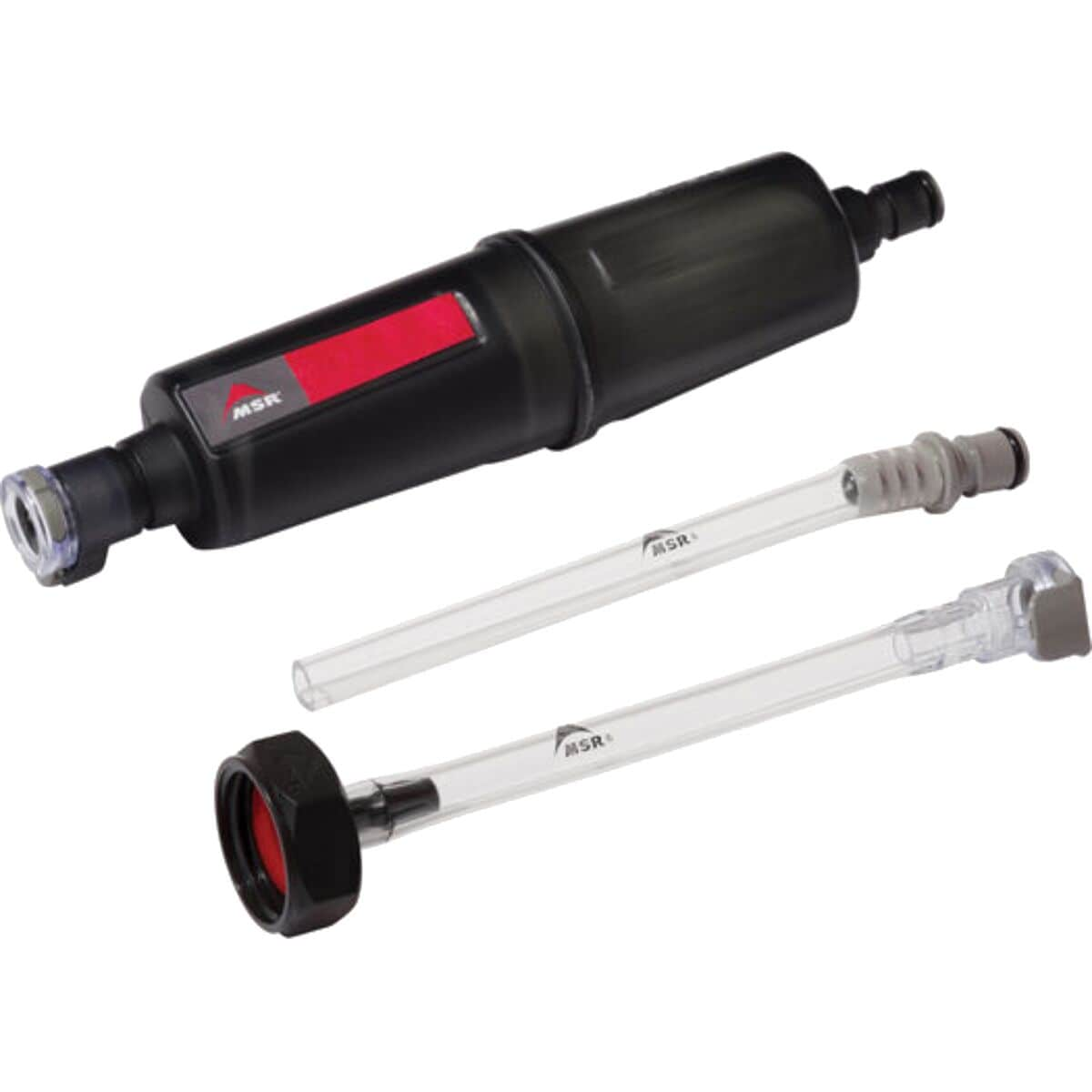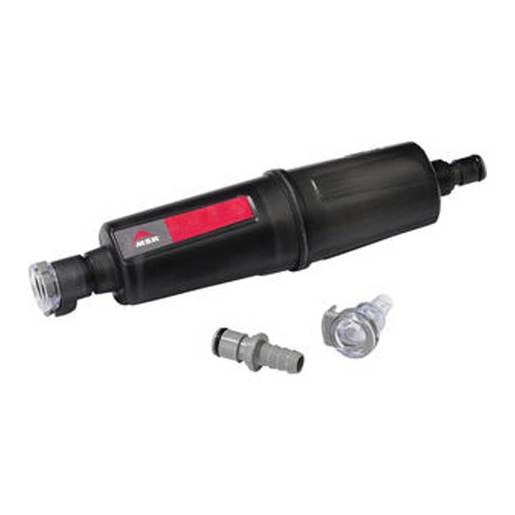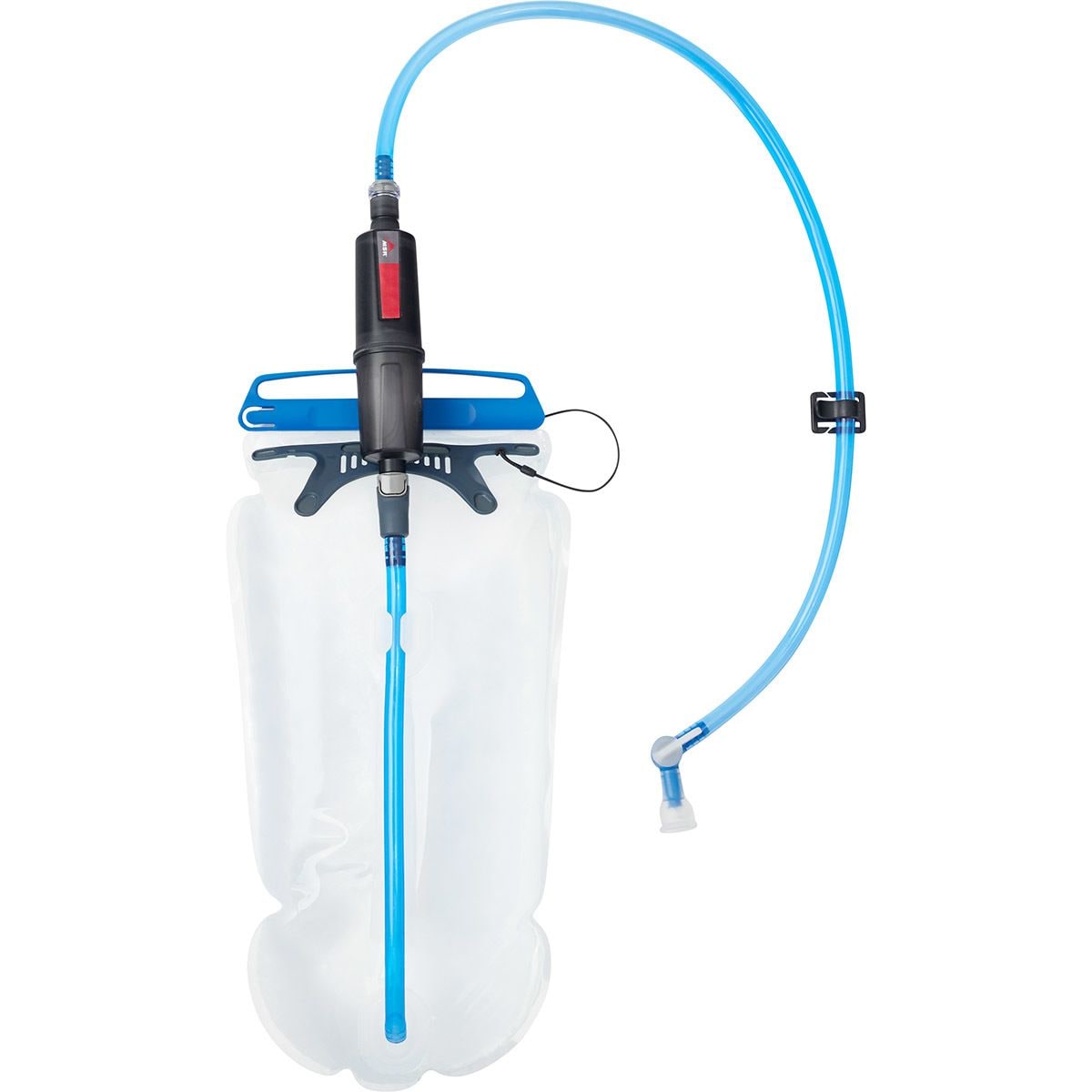The MSR Thru-Link Inline Water Filter is a 0.2-micron hollow-fiber water filter designed for use with a hydration system. It connects inline between the reservoir and the hose, allowing you to fill up the hydration bladder directly at the source and drink clean water on the go. In addition to the hollow fibers, the Thru-Link uses activated carbon to remove chemicals and improve the water’s taste. The most exciting innovation of the Thru-Line is the ability to test whether the filter has been compromised because of freezing or impact in the field. The uncertainty of knowing whether the filter is still working has been the Achilles heel of other hollow-fiber filters on the market and the Thru-Link provides a solution.
Specs at a Glance
- Weight (Manufacturer): 2.5 oz. This is the weight when the filter is completely new and dry. We measured the wet weight (after passing water through and then shaking out the excess) to be 4.4 ounces. This is more accurate to the weight you’ll actually carry on the trail when using this filter.
- Length x Width: 7.5 in X 1.6 in
- Filter type: hollow fiber w/activated carbon to filter chemicals and improve taste
- Pore size: 0.2 microns;
- Filters: Bacteria, chemicals/toxins, particulate matter (like dirt and microplastics), protozoa. Does not filter viruses.
- Flow rate: 1.5 liters per minute
- Filter life: Not available
Prepare the filter at home before your first trip
Do not grab a Thru-Link filter at a camping store en route to your destination and expect it to work out of the box. There are a couple of things you need to do to set it up at home, starting with figuring out how you will attach the filter to your water bladder. You need to ensure that the inner diameter of the hose of your system is ¼ inch (6.35 mm) for a proper fit. Then you need to figure out where in the system you want your filter tube attached. Some hydration bladders have quick connectors that the filter can clip right into. If yours doesn’t, the Thru-Link comes with quick connectors that you can pressure fit onto the bladder and hose.

It can take some experimentation to determine the best placement of the water filter, and you may need to buy some extra hydration tubing to do this testing. MSR doesn’t give a specific recommendation about this because each hydration bladder and the placement of it within different model backpacks varies. Hydration systems alone can cause a bulge in the back of your pack, and the filter adds a rigid element as well. If you’re using a backpack without a dedicated external hydration sleeve, you may find it difficult to place and remove the hydration bladder and filter into your full backpack.
To me, the ideal setup would use a long hose that places the filter entirely outside the hydration sleeve, possibly strapped to the upper portion of a shoulder strap. Another good option could be to use it with a trampoline-frame ventilated backpack that allows you to externally clip the water bladder in the space between the ventilating mesh and the back of the pack, with the filter on the opposite side of the bladder from your back.
The second thing you need to do at home is to flush out the carbon before use or you’ll end up with a mouthful of it. The activated carbon works in the same way your home water filtration pitcher works to improve the taste of water and remove chemicals. \Where I primarily hike, I’m not concerned about chemical runoff or improving the taste of the water, so I don’t personally need the carbon. But I understand that hikers with these concerns of their water sources may appreciate it.

Filling the hydration reservoir
If your hydration reservoir doesn’t have a quick-release hose attachment, and you installed the one that comes with the Thru-Link filter, be forewarned that it does not stop the flow of water when it’s disconnected, as some built-in models do. This means when you fill your hydration bladder from a water source, it will rush out of the quick-release valve, so you need to hold your thumb over the hole while you fill it, then quickly take your thumb off and connect the filter before too much water escapes. I’m glad MSR included a quick-release hose attachment with the filter, but I wish it didn’t allow water to exit, as it makes filling the bladder awkward.

Cleaning the Filter in the Field
No additional equipment is required to backflush the Thru-Link. Simply suck water to fill the drink tube, detach the filter from the bladder, and blow the water in the tube forcefully through the filter. Then reattach the filter.
What if the Filter Freezes?
If a hollow-fiber filter freezes, it may no longer provide adequately safe filtration, but with most filters, there’s no way to tell if the fibers are damaged or not. This has led to lots of hikers tossing their filters and buying new ones rather than risk getting sick. The ability of the MSR Thru-Link to test the integrity of the filter in the field is a game-changer for hollow fiber filters. You still have to protect it from freezing and impact, and you should always carry a lightweight backup, like chemical treatment, but the ability to confirm its effectiveness is a big deal.
The following video from MSR shows how you can perform an integrity check. The only thing you need besides the filter and your hydration bladder is your cookpot, so it can easily be done in the field.
MSR also states that the filter can be damaged through impact, like a hard fall. While I’m less clear how this could hurt the hollow fibers, I definitely see how an impact could knock the carbon barrier out of place. If this happens in the field, you could run your filtered water through a bandana into your pot or mug to trap the carbon pieces.
Use as a gravity filter
The Thru-Link can be used as a gravity filter in-camp, but that’s not its ideal use case, because you have to squeeze the bite valve continuously while filling your secondary container unless you take the bite valve entirely off the tube.
Not for direct use with silty or muddy water
The included paper instructions state that the Thru-Link will clog quickly if you use it with “silty, cloudy, muddy, glacial stream or tea-colored water.” But this is pretty standard with any hollow-fiber filter. In these cases, you should pre-filter the sediment out before filling up your hydration bladder.
Comparable Inline Water Filters and Purifiers
| Make / Model | Type | Pore Size | Filter Life | Price |
|---|---|---|---|---|
| Aquamira Frontier Red Purifier | Purifier | NA | 450L | $40 |
| Aquamira Frontier Green Filter | Filter | NA | 400L | $20 |
| HydroBlu Versaflow Filter | Filter | 0.1 micros | 100,000 L | $20 |
| Lifestraw Flex | Filter | 0.2 microns | 2,000L | $35 |
| MSR Thru-Link Filter | Filter | 0.2 microns | NA | $40 |
| Platypus Gravity Works Filter | Filter | 0.2 microns | 1,500L | $55 |
| RapidPure Scout Purifier | Purifier | 0.2 microns | 100 L | $30 |
| Sawyer Mini Water Filter | Filter | 0.1 microns | 400,000L | $22 |
| Sawyer Dual Threaded Mini Water Filter | Filter | 0.1 microns | 400,000L | $25 |
Recommendation
The MSR Thru-Link is a great inline water filter that allows you to fill from sources on the go and filter as you drink, without having to carry separate vessels for dirty and clean water. I do wish that the quick attach connectors prevented water from spilling out when the hose is disconnected, but the ability to verify that your filter is still working in the field, especially when there is a danger of freezing, mitigates the biggest problem with hollow-fiber filters and is a great development. On most of my trips, I prefer using water bottles, so I’m hoping the integrity-check technology filters down to other products on the market, or that MSR develops a version of the Thru-Link that can be used with bottles.
Disclosure: MSR provided the author with a filter for this review.
SectionHiker is reader-supported. We only make money if you purchase a product through our affiliate links. Help us continue to test and write unsponsored and independent gear reviews, beginner FAQs, and free hiking guides.Compare 3 Prices
-

 Backcountry.com
Backcountry.com$49.95$37.46View -

 Amazon US$49.95View
Amazon US$49.95ViewAmazon.com Price: $49.95 (as of 04/20/2024 04:59 GMT-0400) Details
Product prices and availability are accurate as of the date/time indicated and are subject to change. Any price and availability information displayed on Amazon.com at the time of purchase will apply to the purchase of this product.
-

 Sportsman's Warehouse$49.95View
Sportsman's Warehouse$49.95View -

 Backcountry.com$49.95View
Backcountry.com$49.95View
 SectionHiker.com Backpacking Gear Reviews and FAQs
SectionHiker.com Backpacking Gear Reviews and FAQs 
Do you have any info as to whether the technique they showed on testing to see if the filter is compromised would work on other filters, such as Sawyer?
I’d be very cautious about going there. The insides of all of these filters are different, especially sawyers.
I kind of figured if there was a way to check the Sawyers, we’d have heard it by now. So far, I’ve always managed to keep mine from freezing by having them in my pocket or sleeping bag at all times once wet.
Is there a significant difference in safety from .1 microns to .2 microns?
Cheri – The simple answer is that the difference is only a marginal in the US back country. Convenience of use for your purpose so that you will actually use it matters more.
Mostly the concern is for protozoa like Giardia (~8-14 microns) and Crypto (~4-6 microns) and to some extent bacteria ( > 0.3 microns). Viruses which are typically much smaller (~0.02 to 0.3 microns) are not generally an issue in US back country water sources. A 0.2 micron filter will not remove most viruses. A 0.1 microns “absolute” as Sawyer claims (which I assume means nothing bigger) should filter out some larger viruses but it won’t filter out all viruses and not the ones we are commonly concerned about (eg. noro, roto and Hepatitis A which are all < 0.05 microns). Given this, the choice between 0.1 and 0.2 should probably not be the primary factor in your decision.
If you suspect a water source you have to use might contain viruses…say because it is used by livestock or is too close to heavily used irresponsible camping or bathing for example… then 0.1 will help but you are probably better off employing an additional method after filtration such as boiling or Chlorine Dioxide which will kill or deactivate viruses. All other methods benefit from filtering first since the filter removes particulates where the nasties hide and Crypto which is very hard to kill…For example Crypto takes 4 hrs to be sure with Chlorine Dioxide (eg Katadyn Micropur MP1/AquaMira drops or tablets). If you have filtered with a 0.1 or 0.2 filter then any Crypto or bacteria will be removed. After that, 15 mins of treatment time should be sufficient to kill/deactivate viruses when used as directed (consult the manufacture's instructions for whatever product you use).
Some reviewers of REI note that the ends have broken with compressing a pack etc. How likely is this to happen? I decided to get the hydroblu instead.
Some reviewers of REI note that the ends have broken with compressing a pack etc. How likely is this to happen? I decided to get the hydroblu instead.
I’m only a test sample of one, and mine hasn’t broken, but I believe that my suggestion above of cutting the tube and placing the filter outside of the backpack or running it in an external sleeve or the space behind a trampoline backpad would help to reduce the possibility of this, as well as making it easier to access and less uncomfortable against one’s back.